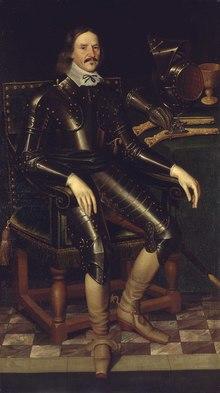Sir Michael Livesey, 1st Baronet, MP (1611–1663), was a Parliamentarian Colonel of Kentish Yeomanry and one of the regicides of King Charles I.
A baronet, seated at Eastchurch on the Isle of Sheppey, Livesey was a zealous Puritan who sided with Parliament during the Civil War.
Life
An active County Committee member, he was appointed Sheriff of Kent in 1643. Livesey commanded Kent Yeomanry, but in 1644, amid accusations of cowardice and threats of mutiny, he challenged the authority of Sir William Waller and detached his cavalry from Waller's command. A partial reconciliation was reached when their disagreement was brought before the Committee for Both Kingdoms in September 1644, and Livesey's troops rejoined Waller's army until the spring of 1645. Livesey refused to serve in the New Model Army and his regiment was taken over by Henry Ireton.[1]
In September 1645, Livesey was elected recruiter MP for Queenborough, Kent, and emerged as a radical Independent and Republican. When pro-Royalist riots broke out in Kent in December 1647, Livesey was sent to quell them; he remained in the south-east during 1648, quelling a 600-strong pro-Royalist riot in Horsham and harshly suppressed further suspected Royalist activity in the county. During July, he pursued the Earl of Holland's insurgents after they attempted to capture Reigate Castle, and then defeated them at Kingston in Surrey, thus ending the threat of a Royalist uprising in the environs of London.[2]
Appointed a Commissioner, Livesey was a signatory to the King's death warrant and was an active Member of the Rump Parliament, where he emerged as deeply hostile to Royalists and Papists. Like other Republicans, he opposed the establishment of the Protectorate in 1653, but occupied himself with local duties: he served as High Sheriff of Kent between 1655 and 1656.[3]
Denounced as a regicide at the Restoration, he and his wife fled to the Low Countries. Sir Michael died in 1663,[4] and Dame Elizabeth Livesey, daughter of Sir Henry Fynes (1587–1641), died without issue in 1666.[2]
See also
- Livesey baronets
References
- ^ "'March, 1659/60: An Act for Setling the Militia within England and Wales.', in Acts and Ordinances of the Interregnum, 1642-1660, ed. C H Firth and R S Rait". London: British History Online. 1911. pp. 1425–1455. Retrieved 29 July 2020.
- ^ a b "Sir Michael Livesey". BCW Project. Retrieved 29 July 2020.
- ^ "Richard Kilburne-A topographie or survey of the county of Kent" (PDF). Archived from the original (PDF) on 18 March 2014.
- ^ Livesey Memorial at All Saints', Eastchurch, Kent
| Baronetage of England | ||
|---|---|---|
| New creation | Baronet (of East Church) 1627–1660 | Attainted |
